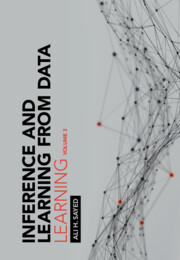Refine search
Actions for selected content:
48274 results in Computer Science
Argumentation models and their use in corpus annotation: Practice, prospects, and challenges
-
- Journal:
- Natural Language Engineering / Volume 29 / Issue 4 / July 2023
- Published online by Cambridge University Press:
- 28 February 2023, pp. 1150-1187
-
- Article
- Export citation
8 - Active Labour Market Programmes and Employer Engagement in the UK and Germany
-
-
- Book:
- Employer Engagement
- Published by:
- Bristol University Press
- Published online:
- 18 January 2024
- Print publication:
- 28 February 2023, pp 126-144
-
- Chapter
- Export citation
A new lifetime distribution by maximizing entropy: properties and applications
- Part of
-
- Journal:
- Probability in the Engineering and Informational Sciences / Volume 38 / Issue 1 / January 2024
- Published online by Cambridge University Press:
- 28 February 2023, pp. 189-206
-
- Article
-
- You have access
- Open access
- HTML
- Export citation
List of Figures and Tables
-
- Book:
- Employer Engagement
- Published by:
- Bristol University Press
- Published online:
- 18 January 2024
- Print publication:
- 28 February 2023, pp v-vi
-
- Chapter
- Export citation
List of Abbreviations
-
- Book:
- Employer Engagement
- Published by:
- Bristol University Press
- Published online:
- 18 January 2024
- Print publication:
- 28 February 2023, pp vii-viii
-
- Chapter
- Export citation
2 - Varieties of Policy Approaches to Employer Engagement in Activation Policies
-
-
- Book:
- Employer Engagement
- Published by:
- Bristol University Press
- Published online:
- 18 January 2024
- Print publication:
- 28 February 2023, pp 15-33
-
- Chapter
- Export citation
6 - The Weakest Link? Job Quality and Active Labour Market Policy in the UK
-
-
- Book:
- Employer Engagement
- Published by:
- Bristol University Press
- Published online:
- 18 January 2024
- Print publication:
- 28 February 2023, pp 87-105
-
- Chapter
- Export citation
Frontmatter
-
- Book:
- Employer Engagement
- Published by:
- Bristol University Press
- Published online:
- 18 January 2024
- Print publication:
- 28 February 2023, pp i-ii
-
- Chapter
- Export citation
Quinductor: A multilingual data-driven method for generating reading-comprehension questions using Universal Dependencies
-
- Journal:
- Natural Language Engineering / Volume 30 / Issue 2 / March 2024
- Published online by Cambridge University Press:
- 27 February 2023, pp. 217-255
-
- Article
-
- You have access
- Open access
- HTML
- Export citation
Obtaining molecular hydrogen from water radiolysis in the nano-SiO2(d = 20 nm)/H2O system under the influence of γ-quanta
-
- Journal:
- Experimental Results / Volume 4 / 2023
- Published online by Cambridge University Press:
- 27 February 2023, e19
-
- Article
-
- You have access
- Open access
- HTML
- Export citation
THE ZHOU ORDINAL OF LABELLED MARKOV PROCESSES OVER SEPARABLE SPACES
- Part of
-
- Journal:
- The Review of Symbolic Logic / Volume 16 / Issue 4 / December 2023
- Published online by Cambridge University Press:
- 27 February 2023, pp. 1011-1032
- Print publication:
- December 2023
-
- Article
- Export citation
First checklist triggering the inventory of marine fish ectoparasites in the Syrian coast (Eastern Mediterranean)
-
- Journal:
- Experimental Results / Accepted manuscript
- Published online by Cambridge University Press:
- 27 February 2023, pp. 1-17
-
- Article
-
- You have access
- Open access
- Export citation
Joining forces: the value of design partnering with operational research to improve healthcare delivery
-
- Journal:
- Design Science / Volume 9 / 2023
- Published online by Cambridge University Press:
- 27 February 2023, e4
-
- Article
-
- You have access
- Open access
- HTML
- Export citation
AXIOMS FOR TYPE-FREE SUBJECTIVE PROBABILITY
- Part of
-
- Journal:
- The Review of Symbolic Logic / Volume 17 / Issue 2 / June 2024
- Published online by Cambridge University Press:
- 27 February 2023, pp. 493-508
- Print publication:
- June 2024
-
- Article
- Export citation

Inference and Learning from Data
- Learning
-
- Published online:
- 24 February 2023
- Print publication:
- 22 December 2022
-
- Textbook
- Export citation
Chapter 9 - Hecate
- from Part III - Public Reimaginings
-
-
- Book:
- Reimagining Shakespeare Education
- Published online:
- 02 February 2023
- Print publication:
- 23 February 2023, pp 145-158
-
- Chapter
- Export citation
Introduction
- from Part IV - Digital Reimaginings
-
-
- Book:
- Reimagining Shakespeare Education
- Published online:
- 02 February 2023
- Print publication:
- 23 February 2023, pp 205-208
-
- Chapter
- Export citation
Notes on Contributors
-
- Book:
- Reimagining Shakespeare Education
- Published online:
- 02 February 2023
- Print publication:
- 23 February 2023, pp xiii-xxii
-
- Chapter
- Export citation
Chapter 7 - The Warwick–Monash Co-teaching Initiative
- from Part II - Reimagining Shakespeare with/in Universities
-
-
- Book:
- Reimagining Shakespeare Education
- Published online:
- 02 February 2023
- Print publication:
- 23 February 2023, pp 113-126
-
- Chapter
- Export citation










